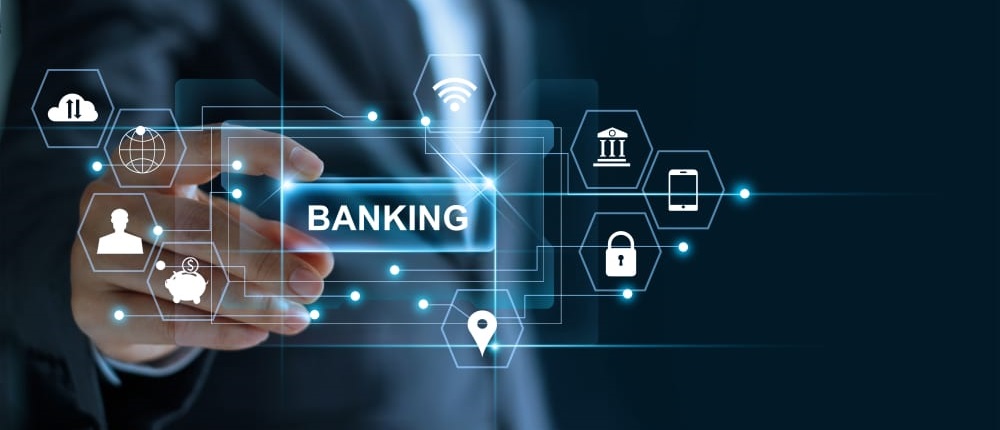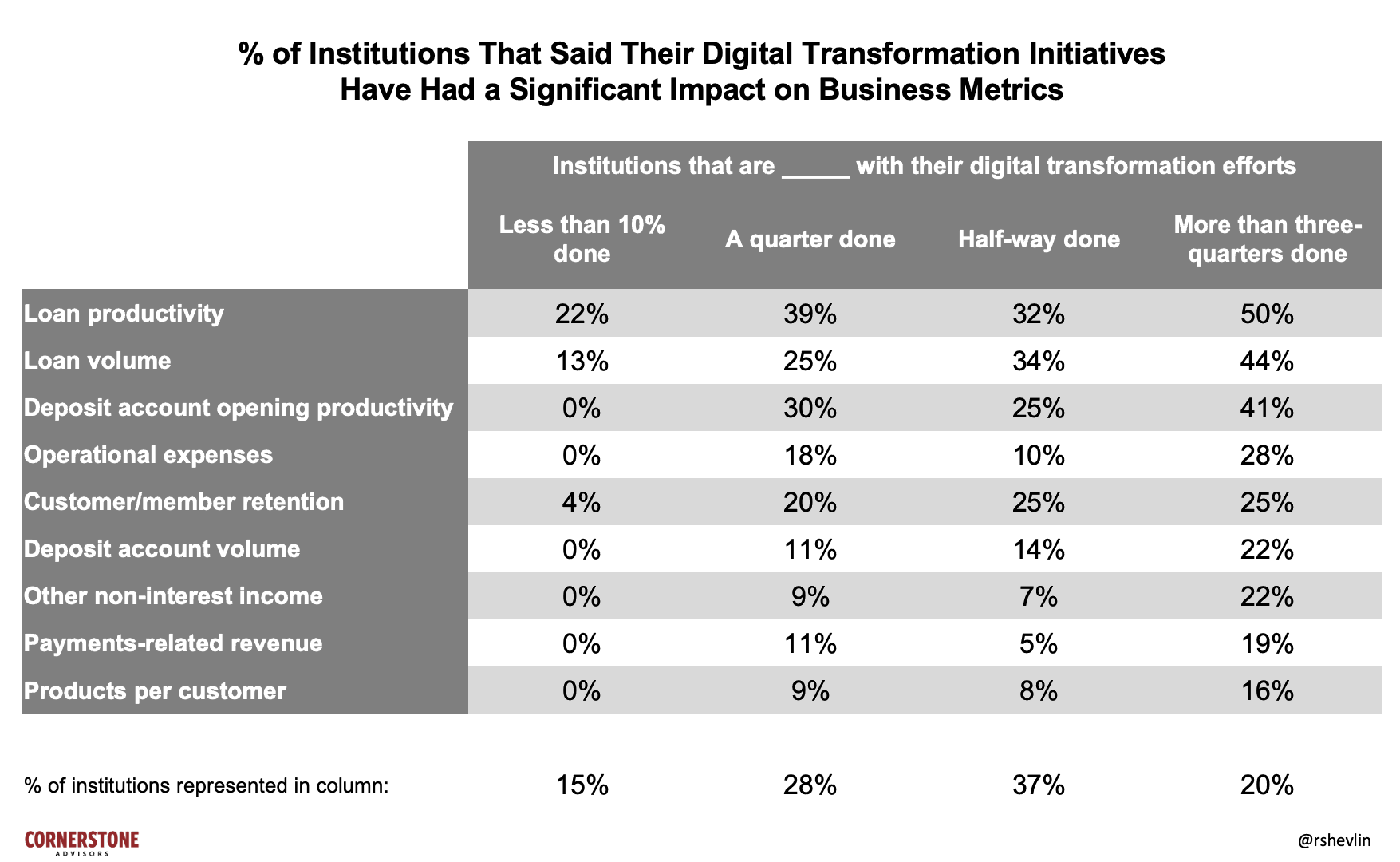The end of digital transformation in banking

an article written by Ron Shevlin, the Chief Research Officer at Cornerstone Advisors
Observations from the fintech snark tank
Bank and credit union executives are holding a loaded gun pointed at their feet. The name on the gun is “digital transformation.” Banks are deluded into believing they’re digitally transforming their organizations when all they’re doing is deploying new tools for yesterday’s industry.
Digital Transformation is Pervasive in Banking
According to Cornerstone Advisors’ 2022 What’s Going On in Banking study, to date, three-quarters of banks and credit unions have launched a digital transformation initiative. Another 15% plan to develop a digital transformation strategy in 2022.
How far along in their digital transformation strategies are the banks?
Of those that launched their initiative in 2021, 28% said they’re already halfway or more done. And among those launched their strategy in 2020, almost half (46%) are at least halfway done with their strategy.

These have to be the fastest transformations in the history of mankind.
Digital Transformation Impact is Lacking
Banks’ perceptions of how far they’ve come in their digital transformation journeys don’t jive with the impact they think they’ve seen.
Not surprisingly, banks who think they’re only 10% (or less) through their digital transformation strategy have little to show for it so far.
But roughly four in 10 institutions who are a quarter of the way done with their efforts say that they’ve seen a “significant” (defined as greater than 10% improvement) impact on loan productivity. That’s a higher percentage than the banks who are half way through their strategy said they’ve had.
Among the banks and credit unions who believe they’re three-quarters or more done with their digital transformation only half have seen significant improvements in loan productivity, 28% report significant reductions in their operational expense structure, and less than one in five have generated significant increases in payments revenue and other non-interest income.

Maybe I don’t understand the meaning of the word “transformation.”
Digital Transformation Delusions
I’m not calling anyone a liar, but it’s hard to believe that banks are as far along in their digital transformations as they think they are. Among other requirements, digital transformation efforts should be addressing core system limitations and emerging artificial intelligence (AI) tools and technologies—but they’re not.
Replacing Legacy Technology
Just 16% of financial institutions said their core vendors have made “significant” contributions to their digital transformation efforts. One respondent to Cornerstone’s survey commented:
“While fintechs and other vendors tout that even small institutions can compete digitally, we are handcuffed by the slowness and unwillingness of core provider to support integrations. And have found that what is in sales pitch then has challenges to overcome in order to accomplish, even if possible.”
Another commented:
“The future is not monolithic platforms the Big 3 continue to shove down our throats. The shift towards the cloud and open APIs is inevitable. We need core solutions with fully documented and open REST APIs without needing to spend an additional seven figures on platforms like Mulesoft. We also need core vendors willing to put together their own low-code/no-code software factories so we can easily extend the core.”
According to Steve Williams, President of Cornerstone Advisors:
“The differing perceptions stem from the fact that institutions below $50 billion in assets aren’t really positioned to ‘go it alone’ and merely consume technology from big players. As the core providers have grown, it feels like there is less ‘roll up the sleeves’ time between banks and vendors dealing with thorny issues of execution.”
The blame can’t be totally pinned on the vendors, however.
Seven in 10 banks don’t plan to replace their core systems as part of their digital transformation. In addition, few have deployed—or plan to deploy—core integration/ middleware platforms or payment hubs. Without these platforms and without replacing the core system, it’s hard to see how digital transformation can be achieved.
According to Brad Smith, Partner at Cornerstone Advisors:
“Digital transformation is forcing a core system decision at many institutions: Double down on digital with our core vendor or go with a best-in-class digital platform? Increasingly, many choose to go best-in-class because they believe the core vendors can’t keep up on innovation, user experience, and integration. And many are now choosing next-generation, digital-first cores to run their digital banks with an eye towards eventually converting their legacy bank over to these next-gen cores.”
Deploying AI Tools and Technologies
Conversational AI is becoming a foundational technology in banking. Why?
Process quality. Abandonment rates for digital product applications in banking are horrendously high. Even more troublesome: just a minority of institutions follow up with would-be applicants within a business day. That’s unacceptable. Banks need to make conversational AI tools components of critical business processes—not just generic sales and service tools.
Data. Attempts to codify and store “data” collected through human interactions—and even from clickstream data—is incomplete, generally inaccessible to other applications that could benefit from the data, and hard to analyze. Data gleaned from chatbot interactions can overcome these shortcomings. Banks need to make chatbots part of their data management strategies—not just their sales and service strategies.
Personalization. Too many banks think of personalization in terms of personalized messages. Smart banks understand that good personalization requires personalized conversations. They still wrestle, however, with getting the data to deliver good personalization, and creating opportunities to have personalized conversations.
However, among institutions that think they’re three-quarters of the way through their digital transformation strategy (or more), just 18% of them have deployed chatbots. A larger percentage of institutions who aren’t as far along in their transformation journeys have deployed chatbots. That doesn’t make sense.

Machine learning, a technology many believe will have a transformational impact on banking, is even less penetrated among banks.
Banks are Not Transforming for the Future of Banking
Underlying the shortcomings in banks’ transformation efforts is this one problem: Few are transforming for the future of the industry, while most are “transforming” for yesterday’s industry.
In other words, they’re simply playing catch-up, making investments and changes they should’ve have made five (or more) years ago.
While the future is uncertain and the end is always near (according to Jim Morrison), there are trends that will lead to a different banking industry than the one that exists today, one that include:
1) Embedded finance. Embedded finance—the integration of financial services into non-financial websites, mobile apps, and business processes—will help banks generate roughly $50 billion in banking-as-a-service (BaaS) revenue according to an upcoming Cornerstone Advisors report. Few banks, however, have identified BaaS as a strategic priority for their organization.
2) DeFi. In its definition of decentralized finance (DeFi), ethereum.org says DeFi “uses cryptocurrencies and smart contracts to provide services that don’t need intermediaries.” Simon Taylor of 11:FS believes “when it comes to funding real-world lending activity, DeFi may excel” and writes:
“A DeFi protocol performs true peer-to-peer lending. It never holds the asset; it just sets the price between borrowers and lenders. It serves the core function of lending at ultra low cost because it has almost zero fixed costs. In essence, DeFi could cut out the middleman.”
But Taylor goes on to say:
“Many will suggest the goal [of DeFi] is to cut out the middleman, and that’s not wrong; I think it just misses the point. I don’t think we’ll live in a world with no middlemen (they’re already evolving in the DeFi landscape). But I do believe [DeFi is] building an alternative economic backbone for the digital economy.”
I’ve yet to see or hear of a bank’s digital transformation initiative that is thinking about how DeFi will impact the institution’s place in the world.
3) Metaverse. In a blog post titled Metaverse, the end of banking digital transformation?, CoinYuppie speculates that the metaverse will change banking in a number of ways including:
Identify verification. In the metaverse, identity verification will be performed via VR glasses and Metaverse sensor devices which contain a security chip.
Real-time creation of financial products. In the meta universe, virtual product managers use gestures to drag and drop the entire process of digital product manufacturing.
Games and attractions become a source of bank traffic. You can open branches on Mount Everest, in the Tarim Basin, on the Kunlun Mountains, or in Jiuzhaigou. The bank will combine these magnificent landmarks to fully personalize its branches and display its products.
The Digital Transformation Bottom Line
Bank execs need to stop playing this game of digital transformation charades, and recognize that although what they call “digital transformation” may be beneficial to their institution’s short term performance, it isn’t very transformational.
The problem for many banks is that their so-called digital transformation efforts aren’t strategic. In fact, in many institutions, digital transformation strategy isn’t even a part of the organization’s overall strategic planning process. That doesn’t make any sense.
Then there are the institutions who claim that digital transformation is about “cultural” change—not technological change. Really? You might as believe that the Earth is flat if you’re going to persist with that view.
Management fads all have a life cycle, and the changing dynamics of the banking industry is accelerating the end of the digital transformation fad.
Want to hear more about the future of banking? Join me on January 19 for a preview of the upcoming What’s Going On in Banking 2022 report with a focus on topics like cryptocurrency, banking-as-a-service, and fintech partnerships.
About the author
Ron Shevlin is the Chief Research Officer at Cornerstone Advisors, where he publishes commissioned research reports on banking and fintech trends and advises both established and startup financial technology companies. Author of the Fintech Snark Tank on Forbes, Ron is ranked among the top fintech influencers globally, and is a frequent keynote speaker at banking and fintech industry events. Want to talk more fintech? Connect on Twitter or LinkedIn.
Dariusz Mazurkiewicz – CEO at BLIK Polish Payment Standard
Banking 4.0 – „how was the experience for you”
„To be honest I think that Sinaia, your conference, is much better then Davos.”
Many more interesting quotes in the video below:











